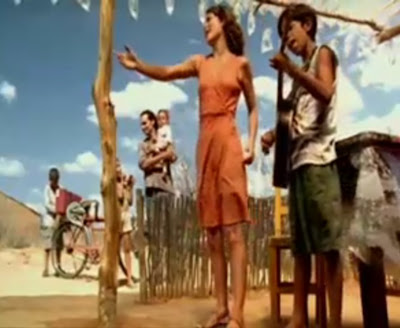The Middle of the Earth - 2003
This film takes place in Brazil starting in the sate of Paraiba where one family sets out en route to Rio de Janeiro for better economic opportunity. The opening scene takes place in front of a sign that reads, ‘Middle of the Earth’ due to the location on the equator being 0’ Latitude. The family ponders the meaning and the audience is shown their innocence as well as general character as they set off on the road.
(Middle of the World)
Violence and other issues such as illegal deforestation are not addressed in the film. Statistically Brazil ranks as one of the top countries for violent crime and has been compared to war zones by the media. Figures of 150 deaths each day in 2006 actually exceeded some combat zones at the time. Neighboring Columbia is said to be one of the top three most dangerous countries in the world including South Africa and Iraq.
The controversy of deforestation is shared by different countries including Brazil. South America is home to 40% of the world’s total rainforest, the Amazon. Although the majority of the Amazon is located in Brazil, it stretches into eight other countries to the north and west. Current logging and slash & burn farming are taking a toll on the forests. It is hard to glance at current satellite images of the area without seeing several highly affected areas. A popular place used as a common example of this is the state of Rondonia, just north of Bolivia. Currently an area of approximately 30,000 square miles has been cleared in this state alone. Slash and burn farming techniques employed by natives, have been destroying the rainforests for decades now with little progress made in the name of prevention. Even in places where logging is banned, middle management easily makes it look legitimate in order to turn profits.
Google Earth has an example of this outlawed logging in a layer called ‘Global Awareness; Greenpeace.’ (Greenpeace = sub layer) What makes this issue so important is that the soil being exposed isn’t capable of sustaining crops for more than a few years forcing a revolving ‘rob Peter to pay Paul’ scenario.
(The line represents 300 miles. El Beni is to the south with another larger area.)
The trip is a modern day version of the Oregon Trail. Although less eventful than most of the actual trip taken across the great plains of North America in the 1850’s, it took the same amount of time and covered about the same distance. The family only ran into real trouble one time when Antonio, was cut for defending his mother in an effort to prove his bravery and manhood to his father. This trip in reality could prove to have far worse consequences due to the amount of crime in the region.





No comments:
Post a Comment